Once you get involved with teamwork, it’s automatically a collaborative process
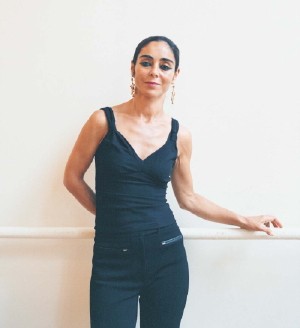
Portrait Marlene Marino
Shirin Neshat’s work continuously refers to the binary correlations of home and exile, solitude and solace, culture and gender, spanning pre- and post-Islamic revolution Iran. Here we spoke to the artist, working with Sakamoto Ryuichi on her most recent film, about the role collaboration plays in her work.
Interview: Olivia Hampton
Collaborating with Sakamoto Ryuichi
– Ever since you launched your artistic career after your first visit to post-1979 Iran, your work has featured collaborative elements. What is the role of collaboration in your work?
All my work has involved some type of collaboration in the past, including my photographic series Women of Allah, but filmmaking has truly been the most collaborative work I’ve ever done, as making films is inherently teamwork. It started with Turbulent (1998), where I first collaborated with the composer/musician Sussan Deyhim, Shoja Azari, who is the male singer in that film, the cinematographer Ghasem Ebrahimian, and many others, all Iranians. We went on to produce a number of films. We were engaged socially, artistically, intellectually.
Since 2003, I have new collaborators. Most recently, I have been adapting the book Women Without Men into a feature film and started working closely with Shahrnush Parsipur, the author of the book, and many others. I actually wrote the script, but she was always a very important part of the development. I also started working with Sakamoto Ryuichi for the music on this project because I thought it was important for me not to work exclusively with Iranians.
– When did you first come across Sakamoto’s work?
A few years ago, I received a wonderful note from him with copies of his videos and some music. I had known his name, of course, but was not so familiar with the range of his work. I fell in love with his music and began to listen to it obsessively. In fact, there were moments when I was editing the film with Philip Glass (Passage, 2001) where I needed some music to edit and I used some of Ryuichi’s earlier music.
When we finally came to work together and discussed the film, I imagined a score that was minimal, emotional and somewhat Eastern. He has since completed music for the short film Zarin, which is a section of the feature-length film, and I couldn’t have been happier with the result. Now, we are looki ng forward to hi s score for the entire feature.
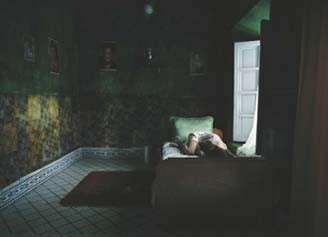
Zarin 2005 Production still
Photo Larry Barns Courtesy Gladstone Gallery, New York
– What was the nature of your collaborative process with Sakamoto?
He started by introducing the type of sounds he was imagining for Zarin. In contrast to the film, which is visually warm and lyrical, he thought of sound that was more electronic, almost industrial and cold. He basically suggested doing without a musical score and using a series of textural sounds instead. I thought it was a great idea, since I had been thinking that some of my work suffered from too much music. So he gave me some elements to listen to, and I went away and started to edit the film and place the elements. We went back and forth a few times: he would watch the film with the previous sounds and would give me more elements. Later, we watched the film together and made some final decisions.
– Then would you say that music and image inspired one another?
Absolutely, for me it is always like that. For example, my film Women Without Men takes place in 1953, so I realized it was important for Ryuichi to become familiar with Iranian music from that period. Conceptually, the historical music appears to represent the sociological aspect of the narrative, while Ryuichi’s music more or less represents the psychological, the inner world of Zarin.
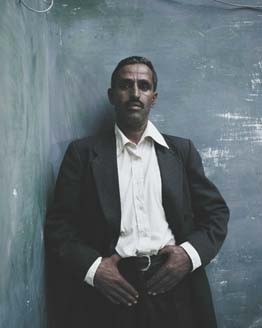
Zarin 2005 Production still
Photo Larry Barns Courtesy Gladstone Gallery, New York
Distinctive filmography
– How would you compare Sakamoto’s role in Zarin to that he has played with other directors, such as Bernardo Bertolucci, Oshima Nagisa and Brian de Palma?
I think his interest in working with me lies in the visual aspect of the work. I believe Ryuichi enjoys working with strong images as much as good narratives. Of course, I was very nervous in the beginning because I was afraid I wasn’t up to his standards. But when we got to know each other, I was impressed with his humility. I found that, like me, Ryuichi takes on projects that are challenging and different than the previous ones.
– Are you planning Women Without Men as a feature-length film?
Yes. We are making a film that is not like an art film shown only in museums. It is really for the general public. It will have a clear linear narrative. In the script, the women’s lives are inter-woven, intercut, because there are five of them and eventually they all mysteriously converge to live together in the garden. We didn’t follow the structure of the book. Also, on the side, I am making individual video installations like Zarin and Mahdokht that are self-contained works based on the nature of each character of the film, but don’t necessarily convey their entire life story and don’t rely on dialogues.
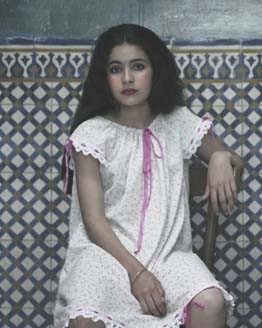
Zarin 2005 Production still
Photo Larry Barns Courtesy Gladstone Gallery, New York
– How long does it take for you to make one short film?
On average, it takes me about a year to make a short film from beginning to end. But for this upcoming feature-length film, I have been working on the script for nearly four years now and have had some 20 drafts! I work with a writer in Berlin and a writer here in New York; I’m constantly flying back and forth. A lot of the script is original, not entirely based on the book, and I have never written before – my past works were mainly designed in storyboards – so it’s been a big challenge. There is a tremendous amount of work and a tremendous number of people involved.
– How do you compare yourself to a conventional filmmaker?
Part of the reason the process of making this first feature-length film has been so slow is because I am not trying to make a conventional film and I don’t have a lot of experience in maing long films. I generally don’t like to overestimate myself. There have been a lot of considerations in making this transition from art to cinema.
Giving birth to that third entity
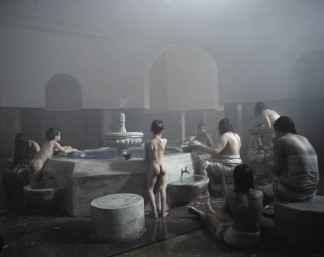
Zarin 2005 Production still
Photo Larry Barns Courtesy Gladstone Gallery, New York
– Did September 11 affect your work and who you collaborated with?
My work was redirected in terms of issues concerned not only with the Iranian people, but with the world at large, including the question of violence that affected every one of us. It made me realize that being away for so long has affected me when it comes to thinking in this ‘third space’: not completely Iranian, not completely American, but somewhere in between. So it made sense for me to work with other people who are also somehow in that third space, as I think Ryuichi is: he is Japanese, lives in New York and is working with Bertolucci and all these international projects, but yet he lives in his own country too; he has his own history.
– Collaboration is also an important part of Sakamoto’s work. Are you interested in the nexus between different cultures, beliefs, forms of expression?
Once you get involved with teamwork, it is automatically a collaborative process. It impels you to learn how to negotiate artistically and professionally. I now look at music in a very diferent way than I did before. Each composer takes me to a different place. Sussan Deyhim is very much about the human voice, Sakamoto is about sound, and there is a huge difference. I had to readapt my mind so that it is not all about music, but the subtlety of sound. It’s all about dancing around each other’s qualities, cultures and personalities, then giving birth to this third entity that contains a little of both people.
– Is this what you would call that ‘third space’?
Exactly. And in the end, my biggest challenge is that I wish to produce a work that is reflective not just of me, my life and culture but also of Sakamoto, and every other prominent artistic member of the film. The difficulty, of course, is how to find that perfect balance. For example, how to make a film that could maintain its Iranian identity within its specific historical and political property – and yet allow Sakamoto, with his unique Japanese/American background and experiences, to bring his own flavor, culture and experiences into the picture.
Shirin Neshat
Born 1957 in Qazvin, Iran, Neshat lives and works in New York City. Her photographic series Women of Allah (1993-97) examined martyrdom in Islam. Turbulent (1998; winner of the 1999 Venice Biennale’s International Award), Rapture (1999) and Fervor (2000) – a trilogy of split-screen video installations – focused on gender dynamics in Muslim societies. Since The Last Word (2003), her films have provided for a more conventional narrative, as with the feature length film and video installation series Women Without Men, currently in progress.
Olivia Hampton
Independent journalist and critic. Born in Paris. Received her MA in Transnational Communications from Goldsmiths College, University of London and her BA in International Relations from American University. Editor of publications and media materials at the Center for Advanced Defense Studies and at Layalina Productions, Inc., a non-profit producer of Arabic- and English-language television programming, in Washington, DC.
Originally printed in ART iT 12 Summer/Fall 2006
http://www.art-it.jp/backnumber_detail.php?id=39
ART iT News: Shirin Neshat takes Silver Lion for best director
